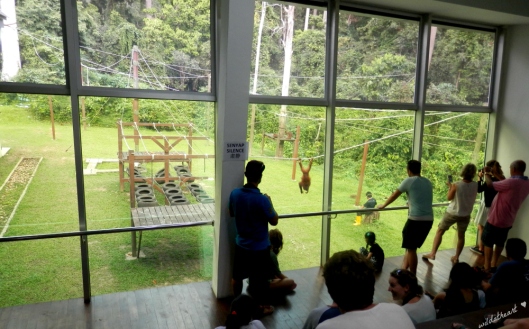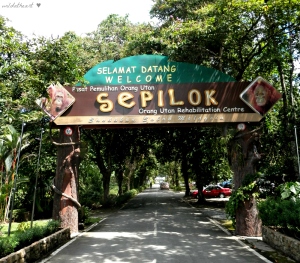Tags
animals, Borneo, conservation, jungle, Malaysia, Orang-utans, orangutan, Rescue Rehabilitation Release, Sabah, Sepilok Orangutan Rehablitation Centre
Here I am, nearing the end of my fourth week at Sepilok, a heavily jungled area of Sabah, northern Borneo. So far I have seen some incredibly unique and ecologically-essential species (see previous blog posts), but nothing has entranced me more than the gregarious Bornean orangutan (Pongo pygmaeus). Orangutans are, if you are new to my journey, the main reason I am here in Malaysian Borneo. Since the beginning of July I have been volunteering at the Sepilok Orangutan Rehabilitation Centre, and I will be here until September.
The Sepilok Orangutan Rehabilitation Centre (SORC) officially came to fruition in 1964 thanks to the joint efforts of passionate English woman, Barbara Harrison, and the Sabah government. 43 square kilometres of protected jungle (the Kabili-Sepilok Forest Reserve) surrounds the actual Centre, which sits on the edge of the forest and now greets tourists with large, welcoming gates. Today at the Centre you will find plenty of educational material (including a fantastic short documentary that talks about SORC’s crucial work), a lovely little souvenir shop, a cafe, and of course ample opportunities to view the vivacious orangutans in a jungle environment. It is well set up for tourists and as such makes a fantastic travel destination on any Borneo itinerary.
SORC works through “RRR” – Rescue, Rehabilitation and Release. Orangutans come to the Centre after being found injured, as illegally-kept pets, or orphaned and alone. Older animals are patched up as required and released back into appropriate areas, whereas youngsters are kept at the Centre until they too are old and confident enough to be released. At the Centre the apes are taught important life-skills such as climbing, swinging, nest-building and foraging. Tourists can even view some of the juveniles at the Outdoor Nursery platform: a jungle-gym right on the edge of the forest that serves as feeding point, training ground and open play area all in one. Youngsters can head out into the surrounding trees, or they can remain at the jungle-gym until they are more comfortable with exploring. Giving the juveniles the freedom to venture out as they like allows them to develop the confidence to interact with their jungle home at their pace, which I think is fantastic.

View of the Outdoor Nursery platform from the tourist’s viewing area

Orangutan at one of SORC’s feeding platforms
The conservation status of the Bornean orang-utan has just been re-assessed by the IUCN (the International Union for Conservation of Nature) and this species is now classed as Critically Endangered – meaning the work of SORC is more vital than ever. The orangutans’ numbers have seen an incredibly sharp decline (an estimated 60%) since the 1950’s, and by 2025 it is theorised that a further 22% decline will be seen – this equates to a population loss of 82% by the year 2025. It is likely that even this is a hopeful number, though, and that the population decline we see over the coming decade will actually be higher. Protecting remaining animals is key to the conservation of the species as a whole, and being able to have a personal involvement with this work of SORC’s is truly inspiring. Over the next few weeks my blog will be focused on the animals, the area, and the incredible work that goes on here. If you are planning a trip to Southeast Asia I would, of course, encourage you to come and see it for yourself – the more support we give to places like SORC, the more the orangutan’s conservation can be funded.
SORC website – Orangutan Appeal UK
Bornean Orangutan IUCN listing



Pingback: England – The Fox Project | Blame it on My Wild Heart Blog
Pingback: ‘Taming’ the timids | blameitonmywildheartblog